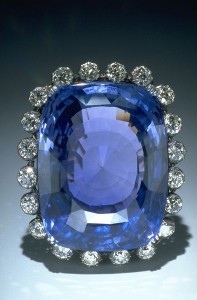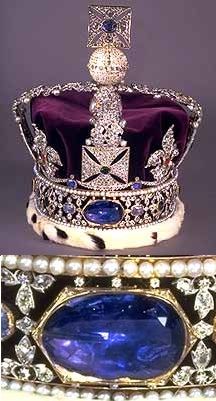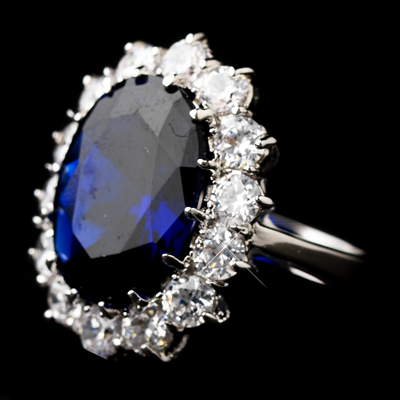All About Sapphires: A Precious Stone
History and Lore of Sapphires
The word Sapphire comes from the Greek word “sappheiros” meaning “precious stone”. Sapphires are a variety of the gem species corundum and occurs in all colors of the rainbow – pink, purple, green, orange, or yellow corundum are known by their color (pink sapphire, green sapphire). It is also a part of the four precious gemstone family, consisting of rubies, diamonds and emeralds.
Blue sapphires range from very light to very dark greenish or violetish blue, as well as various shades of pure blue. The most prized colors are a medium to medium dark blue or slightly violetish blue.
Treasured throughout history, sapphires have always been prized and envied by kings, queens and nobility in general all around the world. Sapphires have been a popular and sought after gemstone since the Middle Ages – Medieval clergy wore sapphire jewelry to symbolize heaven, while commoners thought the gem attracted heavenly blessings and Sapphire always adorned jewelry of the royalty to symbolize holiness, wisdom, virtue and good fortune.
The magnificent striking blue of Sapphires captivated the hearts and attention of humans for centuries. There is a legend in Ancient Persian history, which tells that the earth was resting upon a giant sapphire and that the reflection is what gave the sky its blue color. Sapphires have been associated with sincerity, constancy and truth. The metaphysical properties that are connected to Sapphires are interpretation, insight and clairvoyance. Sapphires have at times symbolized heavenly grace, an apt description for these celestial gems. According to folklore, Sapphires will protect your loved ones from envy and harm.
Given the great history of this amazing precious stone, there is no surprise in the emergence of legendary sapphires, and here are just 10 of the most famous sapphires in history:
This 182-carat star sapphire is from Sri Lanka. It was given to silent film star Mary Pickford by her husband, Douglas Fairbanks Sr., and she bequeathed it to the Smithsonian Institute in 1981.
#2 Logan Sapphire
The 422.99-carat sapphire is one of the largest faceted gem-quality blue sapphires in the world. The piece was a gift to the Smithsonian Institute from Mrs. John A. Logan in 1960.
#3 Rockefeller Sapphire
The Rockefeller Sapphire is a 62.02-carat internally flawless cornflower blue sapphire. It acquired its name from the one time proprietor, John D. Rockefeller Jr. The only son of John D. Rockefeller Sr. purchased the stone in 1934, from an Indian Maharajah thought to have been the seventh and the last Nizam of Hyderabad, Mir Osman Ali Khan, whose period of rule extended from 1911 to 1948.
#4 Bismarck Sapphire Necklace
The 98.6-carat deep blue Sri Lanka sapphire is set in a diamond and platinum necklace, which was designed by Cartier. Gifted to the Smithsonian Institute by Countess Mona Von Bismarck in 1967.
#5 Maria Alexandrovna Sapphire Brooch
During the Great London Exhibition of 1862, Russian Emperor Alexander II purchased a sapphire weighing 260.37. The Emperor presented the stone to his wife Empress Maria Alexandrovna. This stone is rare and known for its combination of size, color, clarity and unusual cut. This piece of history now resides in the Russian Diamond Fund.
#6 The Stuart Sapphire in the Imperial Crown
This famous sapphire weighs in at 104 carats and is set into the Imperial State Crown. This sapphire’s past is somewhat unclear; it was most likely owned by Charles II. It was among one of the many jewels that James II took with him when he fled France. Passed down through the royal families, it came into the hands of Henry Benedict Stuart where the stone received its name. With his passing he left the stone among other relics to King George III. The stone was set into Queen Victoria’s State Crown, just below the Black Prince’s Ruby. In 1937, the crown was replaced with a nearly identical crown that was produced except the Stuart Sapphire was placed in the back of the crown and in its place the Cullinan II Diamond was placed in the sapphires old positioning.
#7 Star of India
The Star of India, is the second-largest and most famous star sapphire in the world weighing in at 563.35 carats. Financier J. P. Morgan presented the sapphire to the New York Museum of Natural History in 1900.
#8 Queen Marie’s Sapphire
Among cut sapphires, the largest in the world is known as Queen Marie of Romanias Sapphire, at 478 carats. It combines stunning color with a fascinating history. According to lab reports, it is of Sri Lankan origin and is completely untreated. It was purchased by King Ferdinand of Romania in 1921 for his wife Queen Marie, who was the granddaughter of both Queen Victoria of England and Czar Alexander II of Russia. The sapphire was sold around 1947 and acquired by Harry Winston. The stone is now on permanent display in the Diamond Fund Exhibition, at the Kremlin Armory Museum in Moscow.
#9 Black Star of Queensland
Black Star of Queensland is a 733-carat (146.6 g) black sapphire, and the world’s largest gem quality star sapphire. It was discovered in the 1930s by 12-year-old Roy Spencer in Queensland, Australia. Since they did not know that sapphires could present themselves in a black color, the boy’s dad dismissed it as an enormous black crystal, threw it aside to be used as a doorstop in their family home. The humble gemstone that spent nine years as a doorstop is now set majestically as a pendant framed by 35 diamonds.
#10 The Royal Blue
The ever famous ring was personally chosen by Diana from a selection presented to her by Garrard Jewelers, making it an unusual royal choice because anyone could purchase it from the Garrard catalog at the time. A large, oval 12-carat sapphire is surrounded by a cluster of 14 diamonds set in 18-carat white gold. When the official engagement photos were released, the ring only had 8 prongs total: 2 in each corner. More prongs were added in December 1981 and the end result is now Kate Middleton’s engagement ring.
There are many speculations as to why Diana chose this particular ring. Sapphires were one of the Princess’ favorite gemstones. Some say she chose it because it reminded her of her mother’s engagement ring. Others say she chose it to match her beautiful blue eyes. Diana later stated that it she picked it because it “was the biggest one.” Whatever the reason, this beautiful ring has indeed become a symbol and an heirloom. When William gave it to Kate he stated, “It’s very special to me. As Kate’s very special to me now, it was right to put the two together. It was my way of making sure my mother didn’t miss out on today and the excitement, and the fact that we’re going to spend the rest of our lives together.”
Buying Sapphires
Sapphire Color
Blue is the best-known of the sapphire colors. The prized Kashmir and Burmese sapphires have a deep blue that is intense and velvety. These sapphires are not often seen on the market today. Sri Lankan and Madagascar sapphires are the most common today, with a wide range of colors from light blue to dark blue.
With blue sapphire, the intensity of blue is the most important factor. An intense, rich pure cornflower blue that is not too dark or too ‘inky’ is the most desirable color. Overall, sapphires that are too dark or too light in color are less valuable, but light-blue sapphires often have greater brilliance that is rarely found in darker blue stones.
 Colorless sapphires are actually quite rare, since most stones will exhibit some faint hints of color.
Colorless sapphires are actually quite rare, since most stones will exhibit some faint hints of color.
Sapphire colors are best viewed under natural daylight. In artificial or incandescent light, sapphire colors can appear darker and inky black-blue. Violet stones are colored by vanadium. Pink sapphire and purple sapphire are often colored by iron and titanium impurities. Most yellow sapphire is naturally on the lighter side. It is through heat treatment that a more intense yellow golden color is produced. Beryllium-treated sapphire may result in brilliant bright yellow. Small traces of iron can cause yellowish and greenish hues in stones. Chromium is known to produce fine pinks (and red in ruby), whilst iron and vanadium together can produce lovely orange stones.
Padparadscha sapphire is a very rare sapphire with a pinkish-orange hue. A true padparadscha will always have a hint of pink. Many ‘green’ sapphires consist of fine alternating bands of blue and yellow sapphire, which are visible under a microscope.
Sapphire Clarity and Luster
Sapphire can occur transparent to opaque – with transparent being the most valuable. Some translucent materials are cut into beads or cabochons. Opaque materials have very little gemstone value, although they may sometimes be used for ornamental carving. Sapphires are generally cleaner than ruby, and it is best to look for stones that are eye-clean.
In some cases, extremely fine silk throughout the stone can enhance the value of some sapphires. The famous sapphires from Kashmir have a velvety blue color which is caused by this fine silk. This same silk causes the asterism seen in star sapphires. However, too much silk weakens the color, rendering it an undesirable grayish color. The rutile needles that are responsible for the silky shine reflect the light in sixty-degree angles. If the rutile needles are perfectly aligned in the same direction, the inclusions can result in six-rayed asterism when cut. Sapphire exhibits an attractive vitreous luster.
Sapphire Cut and Shape
Various shapes and cutting styles are common with sapphires. Ovals, cushions, and rounds are commonly seen, as are other shapes, such as fancy hearts, pears and emerald cuts. Round stones can command very high premiums, especially in diamond-cut calibrated stones weighing 1 carat or more. Cabochons are common for translucent stones or for stones with visible inclusions. Briolettes, beads and tumbled sapphire can also be found, but is usually lower grade material.
Sapphire Treatment
The most common treatment for sapphire is heat treatment, though unheated specimens can be found. Stones are heated (generally before they are cut) to between 1700 to 1800 degrees Celsius (3100-3300 degrees F) for several hours. Most sapphires today are heated, and unheated stones in rich blue can command enormous prices in today’s market.
As a Birthstone and as a Gift
 Sapphires are the traditional September birthstone. They are believed to help banish evil negative thoughts and enhance the positive influences of the planet Venus. It is unsurprising that those born in the month of September would share the same attributes of those found in Sapphire jewels: analytical, observant and precise – reminiscent of the clarity Sapphires possess. This dazzling blue gemstone is bound to bring insight to those born in September.
Sapphires are the traditional September birthstone. They are believed to help banish evil negative thoughts and enhance the positive influences of the planet Venus. It is unsurprising that those born in the month of September would share the same attributes of those found in Sapphire jewels: analytical, observant and precise – reminiscent of the clarity Sapphires possess. This dazzling blue gemstone is bound to bring insight to those born in September.
Sapphire jewelry as a gift are perfect for most precious loved ones. Given as a 45th wedding anniversary gift, Sapphires are a fitting gift for any romantic milestone. Since Sapphires also symbolize wisdom, sapphire jewelry would also make an excellent graduation gift.
























Sapphires….one of the most beautiful gemstones in the world! And the jewelry piece in the image with blue sapphires looks stunning. The information is also very interesting. And all the jewelry pieces are adorable. The write-up is very comprehensive. Thanks!!
Nice Post …..
Good information.
Sapphires are the traditional September birthstone. They are believed to help banish evil negative thoughts and enhance the positive influences of the planet Venus.
The great blog post I love your blog
The information is also very interesting. And all the jewelry pieces are adorable. The write-up is very comprehensive. Thanks
Great Post. Thank you so much for sharing unique information about these sapphires.
Very interesting article, a lot of knowledge provider.
Thanks for sharing such great knowledge.
Lovely information Thank you so much for sharing.
Thanks for sharing this.